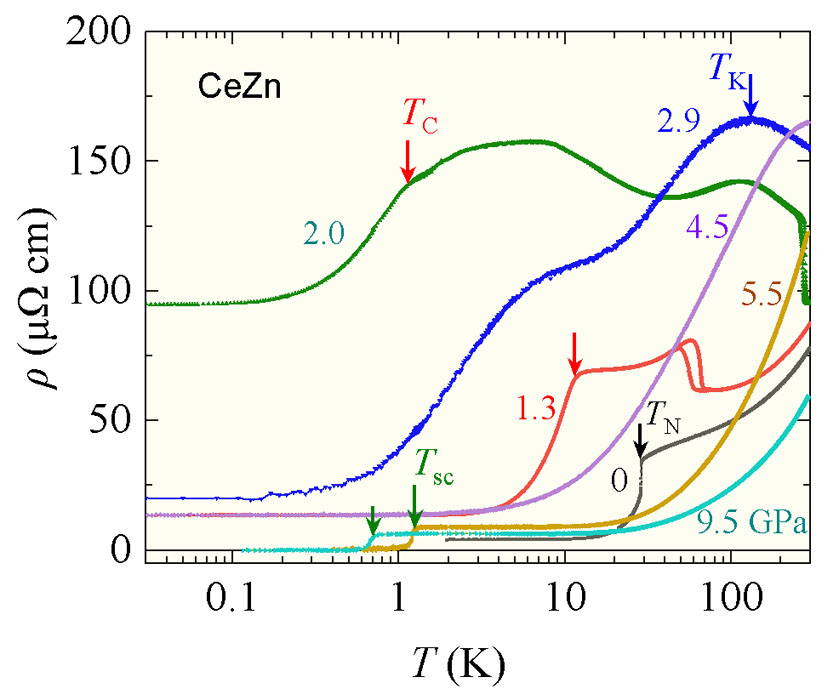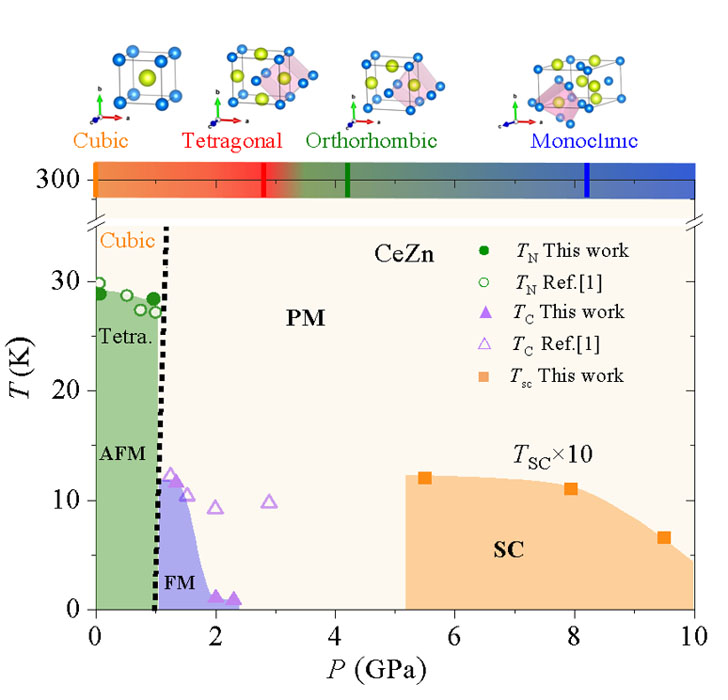Pressure Induced Superconductivity and Multiple Structural Transitions in CsCl-Type Cubic CeZn Single Crystal
Uwatoko Group
The CsCl-type compound crystallizing in cubic structure with chemical formula ReTm (where Re = rare earth elements such as La, Ce, Pr…etc., and Tm = typical metal elements such as Ag, Zn, Cd, …etc.) have been known for last three decades due to their strong correlation between charge, spin, and lattice degrees of freedom. These compounds undergo a cubic-to-tetragonal structural transition on cooling, followed by a magnetically ordered state at a lower temperature.
Among these, CeZn is distinct because the magnetic and structural transitions are coupled, revealing a first-order nature of the transition. CeZn exhibits antiferromagnetic (AFM) order below the Neel temperature, TN ~ 30 K, and a concurrent crystal structural change from cubic to a tetragonal structure [1,2]. So far, the electrical, magnetic, and structural properties of CeZn have been investigated by substituting Cu in place of Zn, CeZn1-xCux [3], and applying pressure up to 2.9 GPa [1]. On applying pressure, the AFM ordering changes to ferromagnetic (FM) ordering above 1 GPa, and the coupled magnetic and crystal structural transitions become separated. The neutron diffraction study [2] pointed that the crystal structure altered from cubic to rhombohedral structure in the FM state. With further increase in pressure, the Curie temperature, TC, of the FM state was found to decrease with pressure, while the structural transition temperature increases and reaches room temperature around 3.0 GPa. However, further investigation of the lattice structure and electronic properties of CeZn at higher pressure has remained unexplored.
CeZn single crystals were synthesized by melting Ce and Zn with a 1:1 ratio as starting material in a tungsten crucible sealed inside a quartz tube under vacuum. Resistivity under high pressure was measured using a clamp type piston cylinder cell and a palm cubic anvil cell. The single crystal X-ray diffraction was carried out by using Rigaku XtaLab HyPix-6000 diffractometer with Mo-Kα radiation (λ = 0.71073 Å).
Figure 1 shows the temperature dependence of the electrical resistivity ρ of a CeZn single crystal at some selected pressures from 300 K down to 30 mK. At ambient pressure, ρ(T) monotonically decreases with temperature and drops suddenly below TN = 29.0 K. It is clear from Fig. 1 that the coupled structural and magnetic transition become separated on increasing pressure above 1.0 GPa, in agreement with the earlier report [1,2]. At 1.3 GPa, the bend at the lower temperature side is assigned to the pressure-induced FM state, while the thermal hysteresis appearing at the high temperature side is attributed to the crystal structural transition. On increasing pressure to 2.0 GPa, FM state shifts towards lower temperature and the crystal structural transition temperature almost reaches to 280 K. Here, it is worthy to note that, in contrast to earlier result [1], in the present case, the crystal structural transition exceeds room temperature at lower pressure. This is clear by the absence of hysteretic behavior in ρ(T) below 300 K even at 2.9 GPa. This difference is attributed to the higher quality of sample used in the present study than the earlier polycrystalline samples [1]. Moreover, at 2.9 GPa, the signature of TC disappears, and another big hump appears around 100 K, implying the pronounced Kondo effect. Up to 5.0 GPa, ρ(T) shows a normal metallic behavior in the measured temperature range. Surprisingly, on slightly increasing the pressure to 5.5 GPa as shown in Fig. 1, ρ(T) displays a pronounced drop below ~1.3 K and reaches zero around 0.8 K, signaling the occurrence of a superconducting state, which survives even up to 9.5 GPa.

Fig. 1. Temperature dependence of electrical resistivity ρ, of CeZn single crystal at some selected pressures. Black and red arrows show the magnetic transition temperatures, TN and TC, respectively. Blue arrow indicates Kondo temperature (TK), and green arrows indicate superconductivity transition temperature (Tsc).
To find the microscopic origin of these anomalies, we performed single crystal X-ray diffraction of CeZn at selected pressures at room temperature. From the X-ray diffraction analysis, we deduce that the crystal structure of CeZn sequentially evolves with increasing pressure from a cubic structure (at ambient pressure) to tetragonal (at 2.8 GPa), orthorhombic (at 4.2 GPa) and finally to monoclinic (at 8.2 GPa). To find a correlation between the crystal structure and the underlying electronic properties with increasing pressure, we have constructed a temperature (T)—pressure (P) phase diagram of CeZn, as shown in Fig. 2. The coupled magnetic transition, PM to AFM state, and the structural transition, cubic to tetragonal structure due to the magnetic striction, at TN decreases hardly up to 1.0 GPa [1,2]. Above 1.0 GPa, the pressure induced an another cubic-to-tetragonal structural transition caused by the band Jahn-Teller effect [4]. The T–P phase diagram reveals that the electronic properties of CeZn also change simultaneously across the structural transitions. First, the ground state changes AFM to FM due to the cubic-to-tetragonal structural transition with pressure. TC decreases rapidly to 1.1 K in the tetragonal structure as pressure increases to 2.0 GPa, implying a possible existence of a quantum critical point. Secondly, at the tetragonal-to-orthorhombic structural transition, CeZn transforms into a nonmagnetic simple metallic state. Finally, superconductivity emerges below Tsc ~ 1.3 K around 5.5 GPa possibly when the crystal structure changes from orthorhombic to monoclinic. The superconducting states survive up to 9.5 GPa in the monoclinic crystal structure. Here, it is worth noting that the T–P diagram of CeZn is different from that of the other Ce-based superconductors, in which superconductivity appears very close to the magnetic quantum critical point, whereas superconductivity in CeZn appears far away from the magnetic state. These results may suggest that the emergence of superconductivity in CeZn under pressure is related to the change in crystal structure implying a nonmagnetic origin of the Cooper pair formation.

Fig. 2. Temperature–pressure phase diagram of CeZn. TN, TC, and Tsc are the Néel temperature, the Curie temperature and the superconducting transition temperature determined from the resistivity data, respectively. For clarity, Tsc has been multiplied by a factor of 10. The stars indicate the pressure value at which the single crystal X-ray diffraction measurements are performed. The tetragonal structure in the AFM region is obtained from Ref. [2]. The cubic to the tetragonal structure boundary line has been used from Ref. [1].
In summary, we have performed systematic electrical resistivity and single crystal X-ray diffraction measurement of CeZn under high pressure up to 9.5 GPa. We find that CeZn exhibits multiple crystal structural transitions under pressure. Simultaneously, across these crystal structural transitions, the signature of modification of the underlying electronic properties of CeZn is also detected. Also, we would like to add that further investigation of how crystal structural change with decreasing temperature at a fixed pressure is required for detailed understanding about the relationship between the crystal structure and electronic properties.
References
- [1] H. Kadomatsu, H. Tanaka, M. Kurisu, and H. Fujiwara, Phys. Rev. B 33, 4799 (1986).
- [2] T. Shigeoka, Y. Uwatoko, H. Fujii, L. Rebelsky, S. M. Shapiro, and K. Asai, Phys. Rev. B 42, 8394 (1990).
- [3] Y. Uwatoko, Y. Fujii, M. Nishi, K. Motoya, and Y. Ito, J. Magn. Magn. Mater. 76, 411 (1988).
- [4] H. Ihrig, D.T. Vigren, J.Kübler, and S. Methfessel, Phys. Rev. B 8, 4525 (1973).
